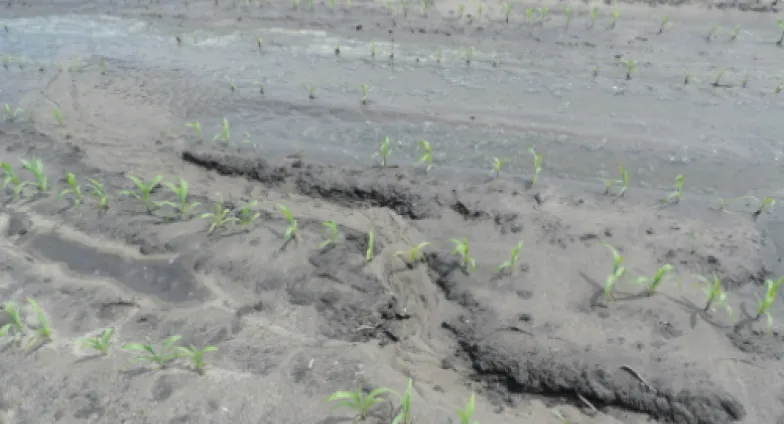Soil Erosion
Erosion is the wearing away of the land surface
Valuable topsoil can be lost due to wind and water erosion, diminishing soil health and potentially increasing nutrient requirements.
Video Series: Erosion in North Dakota
Erosion Processes
Soil erosion processes include deposition, entrainment, transport, and detachment. For management purposes we can focus on detachment. To prevent soil from detaching, particle size or soil mass must be increased, i.e. larger clods of soil hold together better than small clods. Increasing residue on the soil surface and reducing tillage passes and depth will help decrease the detachment of soil particles.

|

|

|
|
Sand particles can move across the surface by saltation |
Larger soil clods or aggregates move across the surface by creep |
Clay particles are suspended from the soil surface into the atmosphere. |
Historic losses in North Dakota
Dr. Dave Franzen, NDSU Extension Soil Specialist, describes the historical soil losses due to wind erosion in North Dakota.
Overview:
When the first settlers started farming land in the Red River Valley of the North they were plowing up 15,000 years of plant growth. Due to the natural fertility farmers had wheat yields ranging from 40-70 bushels per acre in 1885. By the 1930’s the soil started to dry and the wind blew, destroying 10 million acres in ND for crop production (USDA Memo).
Early spring in North Dakota we can still see the effects of wind erosion by the soil in the road ditches. North Dakota’s wind blown soil is traveling farther than the neighbors ditch, much of that soil has been deposited as far as the Atlantic Ocean. As tree rows are taken out of field and tillage practices persist or intensify, we are continuing to loose the native soil fertility that allowed previous generations to achieve 40-70 bu/A of wheat.
Field Examples of Erosion
Abbey Wick NDSU Extension Soil Health Specialist, Dave Franzen NDSU Extension Soil Specialist, and Jodi DeJong-Hughes UMN Extension Educator visited five different fields in North Dakota the winter of 2015 to look at how management impacts soil erosion.

|

|

|
| Conventional tilled soybean field with less than 30% residue, after spring tillage residue covering the soil surface will be less than 20%. | Prevent plant field with multiple tillage passes in the summer/fall | Prevent plant field with a cover crop planted mid-summer |

|

|
| Conventional tilled wheat field with a fall tillage pass that left the soil chunky and less prone to detachment | No-till wheat field with standing stubble that served as a snow catch to evenly distribute the snow across the field, as apposed to drifting in certain areas |
